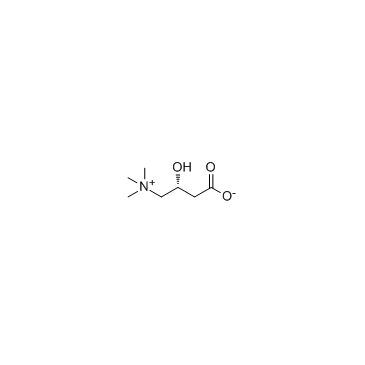541-15-1
| Name | (R)-carnitine |
|---|---|
| Synonyms |
L-(-)-Carnitine
karnitin ST 198 EINECS 208-768-0 3-Carboxy-2-hydroxy-N,N,N-trimethyl-1-propanaminium Hydroxide Inner Salt Carnitrine USPorFCC (R)-Carnitine Ammonium, (3-carboxy-2-hydroxypropyl)trimethyl-, hydroxide, inner salt, L- L-CARNITIN 3-Hydroxy-4-(trimethylammonio)butanoate g-Trimethylammonium-b-hydroxybutirate CAR-OH Vitamin BT Monocamin 1-Propanaminium, 3-carboxy-2-hydroxy-N,N,N-trimethyl-, inner salt (-)-Carnitine Carnitene DL-Carnitine (-)-(R)-3-Hydroxy-4-(trimethylammonio)butyrate carnitine (L-form) (R)-3-Carboxy-2-hydroxy-N,N,N-trimethyl-1-propanaminium hydroxide inner salt γ-Trimethyl-β-hydroxybutyrobetaine Carnitine, (-)- 1-Propanaminium, 3-carboxy-2-hydroxy-N,N,N-trimethyl-, inner salt, (2R)- (R)-3-hydroxy-4-(trimethylammonio)butanoate (-)-L-Carnitin L(-)-Carnitine Carnitine, L- 3-Hydroxy-4-trimethylammoniobutanoate UNII:S7UI8SM58A (L-3-Carboxy-2-hydroxypropyl)trimethylammonium hydroxide inner salt Carnitine DL-form L-Carnitine BICARNESINE Cardiogen 4-Copab L-Carnitine inner salt g-Trimethyl-b-hydroxybutyrobetaine (3R)-3-Hydroxy-4-(trimethylammonio)butanoate Levocarnitine g-Amino-b-hydroxybutyric Acid Trimethylbetaine MFCD00038747 (−)-(R)-3-Hydroxy-4-(trimethylammonio)butyrate D,L-carnitine (±)-carnitine Carniking carnitine Carnitor |
| Description | L-carnitine is constituent of striated muscle and liver. It is used therapeutically to stimulate gastric and pancreatic secretions and in the treatment of hyperlipoproteinemias.Target: OthersL-Carnitine is an endogenous molecule involved in fatty acid metabolism, biosynthesized within the human body using amino acids: L-lysine and L-methionine, as substrates. L-Carnitine can also be found in many foods, but red meats, such as beef and lamb, are the best choices for adding carnitine into the diet [1]. Administering L-carnitine (510 mg/day) to patients with the disease. L-carnitine treatment significantly improved the total time for dozing off during the daytime, calculated from the sleep logs, compared with that of placebo-treated periods. L-carnitine efficiently increased serum acylcarnitine levels, and reduced serum triglycerides concentration [2]. L-carnitine and its derivatives show promise in the treatment of chronic conditions and diseases associated with mitochondrial dysfunction but further translational studies are needed to fully explore their potential [3]. |
|---|---|
| Related Catalog | |
| Target |
Human Endogenous Metabolite |
| References |
| Melting Point | 197-212 °C(lit.) |
|---|---|
| Molecular Formula | C7H15NO3 |
| Molecular Weight | 161.199 |
| Exact Mass | 161.105194 |
| PSA | 60.36000 |
| LogP | -4.52 |
| Index of Refraction | -32 ° (C=1, H2O) |
| Storage condition | 2-8°C |
| Water Solubility | 2500 g/L (20 ºC) |
CHEMICAL IDENTIFICATION
HEALTH HAZARD DATAACUTE TOXICITY DATA
|
| Personal Protective Equipment | dust mask type N95 (US);Eyeshields;Gloves |
|---|---|
| Hazard Codes | Xi |
| Risk Phrases | R36/37/38:Irritating to eyes, respiratory system and skin . |
| Safety Phrases | S26-S36-S37/39 |
| RIDADR | NONH for all modes of transport |
| WGK Germany | 3 |
| RTECS | BP2980000 |
| HS Code | 29239000 |
| HS Code | 29239000 |
|---|


